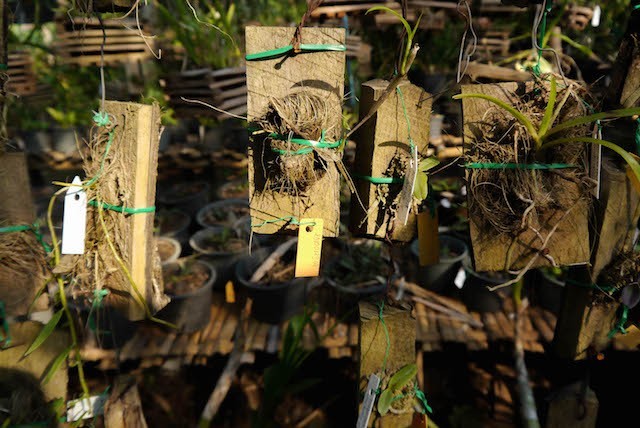Ethno-botany in Laos, the Roots of Culture
By Biba Vilayleck
Man lived first of all in, on and with nature, and to forget this is dangerous. The goal of ethno-botany is to show how plants have always been faithful companions to man. It inventories and examines the vast collection of knowledge, which different cultures have developed across the millennia to tame and master the plant world. Laos remains a plant-based society and we want to preserve that. The plant wisdom of Laos is a part, albeit a small one, of Laotian heritage. Though new techniques and new materials are employed, in the villages people still live “in nature” and with nature.
Our ethno-botanic garden, artificial though it may be, is necessary to show the plants utilised by the Lao today and these number approximately a thousand, but the floristic wealth of Laos is much larger and should comprise, when fully inventoried, more then 12.000 different species.
Showing always involves choosing, making categories where none existed, eliminating details and not considering the complexity, the variability and the spirit of invention of individuals. Food plants are too numerous to present on such a small scale, but here you can admire some specimens of traditional plants, such as those used to colour various fibres, of which we have several examples.
Not every plant is good for humans or animals; you will see some in our garden, which you should be careful of. Others are reputed to coax or repel spirits, and should be approached with caution. Like us, animals are part of nature, and one of the largest – the elephant – finds its food and medicines from the same plants as we do.
Nature has provided us with a certain number of plants which are useful for humans. These are important for a healthy lifestyle, life philosophy and are sometimes considered mystical.
In Laos a large part of the population has no choice other than plants to treat ailments, and the effectiveness of these treatments is directly linked to animist or Buddhist beliefs. Each village has its mò ya, the plant specialist, but also a mò mòn who knows the mantras, and most times it is the same person who performs both roles. Medicinal plants can also be purchased in the marketplace: dried leaves, brown bark and twisted roots of mysterious origin (which are not easily identifiable).
Like many other traditional medical practices, Lao medicine is preventative rather than for healing.
You di mi hèng, “being in good health, having strength”, is its basic principle. This condition of well-being depends on good circulation of the internal breath, lôm, which passes through all the organs; its disturbance leads to disorders called padong. Some illnesses have external causes – natural or supernatural – that are called sannibat. Another source of problems is not respecting the cold/hot equilibrium, which governs living beings.
A human being is made up of 32 elements, or khouane, which must be maintained in harmony by rites that are renewed when anything dangerous occurs.
These rites are called soukhouane (or baci), which can be translated as “attachment of souls”.
You will see several small medicinal gardens here, each devoted to a particular type of problem: those experienced by women; those of the skin (which envelops the body and so requires continual care); those of injuries to the arms and legs, which are numerous due to the hard agricultural work undertaken my most Lao people; those related to the stomach and the whole digestive system.
The spirits are among us Mankind is not alone in nature. Many spirits, called phi in Lao, surround us. The term phi is very general and encompasses several categories of genies and supernatural beings who can be either well-intentioned or evil.
Good phi are generally found in particular locations. They are guardians of places, like the phi ban, the phi muang, the phi heuan – spirits of the village, of the city, of the house. They are honoured with offerings of candles, incense, flowers or fruits. Spirits inhabit the great and beautiful trees. The ton pho (Ficus religiosa) represents Buddha in the pagodas, but in the forest other trees are honoured. They preside over certain curative rites such as “the propping up of the fig”, during which a branch of the tree is held up by a stake so that the sick person (the subject of the rite) is supported as well. Supporting the tree is supporting the person.
Evil phi are everywhere. There are the phi phet, phantoms of people who have accumulated bad karma. Particularly frightening is the spirit of a stillborn child or that of a person killed in an accident. The phi kong koy walks backward to hide its tracks, and the phi pop possesses its victim, who then becomes in turn a phi pop. Fortunately, we can protect ourselves against these intruders by nailing a branch of gna kha (wooly grass, Imperata cylindrica), or a leaf of lep nguak (Euphorbia antiquorum) onto the door of the house, or by burning an irritating wood like that of ton mi (Schima wallichii).
In the courtyard in front of the house we can plant spiny cactuses, which frighten spirits. It is also helpful to wear beneficial leaves like phi seua noy (Vitex trifolia) on one’s body, keeping evil at bay. If a sorcerer has already attacked someone, the sick or possessed person can be struck with a whip made of the leaves of cardamom, kavan (Amomum spp.), to break the spell.
Enjoy a visit of our Ethno-botanical garden to learn more !



